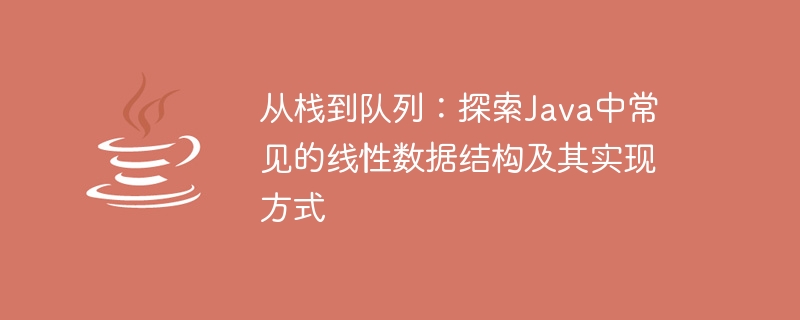Java中常见的线性数据结构及其实现方式:从栈到队列的探索

Java中常见的线性数据结构及其实现方式:从栈到队列的探索
引言:
在计算机科学中,数据结构是组织和存储数据的一种方式。线性数据结构是其中之一,它的特点是数据元素之间存在明确的前后关系。在Java开发中,常见的线性数据结构包括栈和队列,它们的使用频率非常高。本文将深入探索栈和队列在Java中的实现方式,并提供具体的代码示例。
一、栈的概念及实现方式:
栈是一种后进先出(Last In First Out, LIFO)的数据结构。它的特点是只能在栈顶进行插入和删除操作。在Java中,栈的常见实现方式有两种:基于数组的实现和基于链表的实现。
- 基于数组的栈实现:
数组是一种连续存储的数据结构,非常适合用来实现栈。下面是一个基于数组的栈类的示例代码:
public class ArrayStack {
private int[] stack;
private int top; // 栈顶指针
public ArrayStack(int capacity) {
stack = new int[capacity];
top = -1;
}
public boolean isEmpty() {
return top == -1;
}
public boolean isFull() {
return top == stack.length - 1;
}
public void push(int item) {
if (isFull()) {
throw new RuntimeException("Stack is full");
}
stack[++top] = item;
}
public int pop() {
if (isEmpty()) {
throw new RuntimeException("Stack is empty");
}
return stack[top--];
}
public int peek() {
if (isEmpty()) {
throw new RuntimeException("Stack is empty");
}
return stack[top];
}
}- 基于链表的栈实现:
链表是一种非连续存储的数据结构,同样适合用来实现栈。下面是一个基于链表的栈类的示例代码:
public class LinkedStack {
private Node top;
public LinkedStack() {
top = null;
}
public boolean isEmpty() {
return top == null;
}
public void push(int item) {
Node newNode = new Node(item);
newNode.next = top;
top = newNode;
}
public int pop() {
if (isEmpty()) {
throw new RuntimeException("Stack is empty");
}
int item = top.data;
top = top.next;
return item;
}
public int peek() {
if (isEmpty()) {
throw new RuntimeException("Stack is empty");
}
return top.data;
}
private class Node {
private int data;
private Node next;
public Node(int data) {
this.data = data;
this.next = null;
}
}
}二、队列的概念及实现方式:
队列是一种先进先出(First In First Out, FIFO)的数据结构。它的特点是只能在队尾插入元素,在队头删除元素。在Java中,队列的常见实现方式有两种:基于数组的实现和基于链表的实现。
- 基于数组的队列实现:
与基于数组的栈实现类似,下面是一个基于数组的队列类的示例代码:
public class ArrayQueue {
private int[] queue;
private int front; // 队头指针
private int rear; // 队尾指针
public ArrayQueue(int capacity) {
queue = new int[capacity + 1]; // 额外预留一个空位
front = rear = 0;
}
public boolean isEmpty() {
return front == rear;
}
public boolean isFull() {
return (rear + 1) % queue.length == front;
}
public void enqueue(int item) {
if (isFull()) {
throw new RuntimeException("Queue is full");
}
queue[rear] = item;
rear = (rear + 1) % queue.length;
}
public int dequeue() {
if (isEmpty()) {
throw new RuntimeException("Queue is empty");
}
int item = queue[front];
front = (front + 1) % queue.length;
return item;
}
public int peek() {
if (isEmpty()) {
throw new RuntimeException("Queue is empty");
}
return queue[front];
}
}- 基于链表的队列实现:
与基于链表的栈实现类似,下面是一个基于链表的队列类的示例代码:
public class LinkedQueue {
private Node front; // 队头指针
private Node rear; // 队尾指针
public LinkedQueue() {
front = null;
rear = null;
}
public boolean isEmpty() {
return front == null;
}
public void enqueue(int item) {
Node newNode = new Node(item);
if (isEmpty()) {
front = newNode;
rear = newNode;
} else {
rear.next = newNode;
rear = newNode;
}
}
public int dequeue() {
if (isEmpty()) {
throw new RuntimeException("Queue is empty");
}
int item = front.data;
front = front.next;
if (front == null) {
rear = null;
}
return item;
}
public int peek() {
if (isEmpty()) {
throw new RuntimeException("Queue is empty");
}
return front.data;
}
private class Node {
private int data;
private Node next;
public Node(int data) {
this.data = data;
this.next = null;
}
}
}结论:
栈和队列是Java中常用的线性数据结构,有多种实现方式。本文介绍了基于数组和基于链表的栈、队列实现,并提供了具体的代码示例。开发者可以根据实际需求选择合适的实现方式,以提高程序的效率和可维护性。
以上是Java中常见的线性数据结构及其实现方式:从栈到队列的探索的详细内容。更多信息请关注PHP中文网其他相关文章!

热AI工具

Undresser.AI Undress
人工智能驱动的应用程序,用于创建逼真的裸体照片

AI Clothes Remover
用于从照片中去除衣服的在线人工智能工具。

Undress AI Tool
免费脱衣服图片

Clothoff.io
AI脱衣机

AI Hentai Generator
免费生成ai无尽的。

热门文章

热工具

记事本++7.3.1
好用且免费的代码编辑器

SublimeText3汉化版
中文版,非常好用

禅工作室 13.0.1
功能强大的PHP集成开发环境

Dreamweaver CS6
视觉化网页开发工具

SublimeText3 Mac版
神级代码编辑软件(SublimeText3)
 堆和栈的区别
Jul 18, 2023 am 10:17 AM
堆和栈的区别
Jul 18, 2023 am 10:17 AM
堆和栈的区别:1、内存分配方式不同,堆是由程序员手动分配和释放的,而栈是由操作系统自动分配和释放的;2、大小不同,栈的大小是固定的,而堆的大小是动态增长的;3、数据访问方式不同,在堆中,数据的访问是通过指针来实现的,而在栈中,数据的访问是通过变量名来实现的;4、数据的生命周期,在堆中,数据的生命周期可以很长,而在栈中,变量的生命周期是由其所在的作用域来决定的。
 java堆和栈有哪些区别
Dec 25, 2023 pm 05:29 PM
java堆和栈有哪些区别
Dec 25, 2023 pm 05:29 PM
java堆和栈的区别:1、内存分配和管理;2、存储内容;3、线程执行和生命周期;4、性能影响。详细介绍:1、内存分配和管理,Java堆是动态分配的内存区域,主要用来存储对象实例,在Java中,对象是通过堆内存进行分配的,当创建一个对象时,Java虚拟机会在堆上分配相应的内存空间,并自动进行垃圾回收和内存管理,堆的大小可以在运行时动态调整,通过JVM参数进行配置等等。
 对Java Queue队列性能的分析和优化策略
Jan 09, 2024 pm 05:02 PM
对Java Queue队列性能的分析和优化策略
Jan 09, 2024 pm 05:02 PM
JavaQueue队列的性能分析与优化策略摘要:队列(Queue)是在Java中常用的数据结构之一,广泛应用于各种场景中。本文将从性能分析和优化策略两个方面来探讨JavaQueue队列的性能问题,并给出具体的代码示例。引言队列是一种先进先出(FIFO)的数据结构,可用于实现生产者-消费者模式、线程池任务队列等场景。Java提供了多种队列的实现,例如Arr
 队列技术在PHP与MySQL中的消息延迟和消息重试的应用
Oct 15, 2023 pm 02:26 PM
队列技术在PHP与MySQL中的消息延迟和消息重试的应用
Oct 15, 2023 pm 02:26 PM
队列技术在PHP与MySQL中的消息延迟和消息重试的应用摘要:随着Web应用程序的不断发展,对于高并发处理和系统可靠性方面的需求越来越高。队列技术作为一种解决方案,被广泛应用于PHP与MySQL中,以实现消息延迟和消息重试的功能。本文将介绍队列技术在PHP与MySQL中的应用,包括队列的基本原理、使用队列实现消息延迟的方法和使用队列实现消息重试的方法,并给出
 在Java中,add()方法和offer()方法在队列中有什么区别?
Aug 27, 2023 pm 02:25 PM
在Java中,add()方法和offer()方法在队列中有什么区别?
Aug 27, 2023 pm 02:25 PM
Java中的队列是一种线性数据结构,具有多种功能。队列有两个端点,它遵循先进先出(FIFO)原则插入和删除其元素。在本教程中,我们将了解Java中队列的两个重要函数,它们是add()和Offer()。什么是队列?java中的队列是一个扩展了util和collection包的接口。元素在后端插入并从前端移除。java中的队列可以使用链表、DeQueue、优先级队列等类来实现。优先级队列是普通队列的扩展形式,每个元素都有一个优先级。队列的add()方法该方法用于向队列中插入元素。它将定义的元素(作为
 队列在PHP与MySQL中的任务监控和任务调度的实现方案
Oct 15, 2023 am 09:15 AM
队列在PHP与MySQL中的任务监控和任务调度的实现方案
Oct 15, 2023 am 09:15 AM
队列在PHP与MySQL中的任务监控和任务调度的实现方案引言在现代的Web应用程序开发中,任务队列是非常重要的一项技术。通过队列,我们可以将一些需要在后台执行的任务排队,并通过任务调度来控制任务的执行时间和顺序。本文将介绍如何在PHP与MySQL中实现任务的监控和调度,并提供具体的代码示例。一、队列的工作原理队列是一种先进先出(FIFO)的数据结构,可以用来
 PHP秒杀系统中的队列和异步处理优化方法
Sep 19, 2023 pm 01:45 PM
PHP秒杀系统中的队列和异步处理优化方法
Sep 19, 2023 pm 01:45 PM
PHP秒杀系统中的队列和异步处理优化方法随着互联网的迅速发展,电商平台上的各种优惠活动如秒杀、抢购等也成为了用户关注的焦点。然而,这种高并发的用户请求对于传统的PHP应用来说是一个巨大的挑战。为了提高系统的性能和稳定性,解决并发请求带来的压力,开发人员需要对秒杀系统进行优化。本文将重点介绍在PHP秒杀系统中通过队列和异步处理实现的优化方法,并给出具体的代码示
 队列的消息确认和消费失败处理在PHP与MySQL中的实现方法
Oct 15, 2023 pm 01:46 PM
队列的消息确认和消费失败处理在PHP与MySQL中的实现方法
Oct 15, 2023 pm 01:46 PM
队列的消息确认和消费失败处理在PHP与MySQL中的实现方法队列是一种常见的消息传递机制,它可以帮助解决系统中的高并发问题,实现异步处理和解耦。在队列的设计中,消息的确认和消费失败处理是非常重要的环节。本文将探讨使用PHP与MySQL实现队列的消息确认和消费失败处理的方法,并提供具体的代码示例。消息确认在队列中,消息的确认是指消费者成功处理消息后,向队列发送






